
Lieutenant Colonel
A Lieutenant Colonel (LTC) is a senior officer who commands the unit at the battalion level. They provide strategic direction, oversee company-grade officers, and manage the overall chain of command. Rather than leading units directly in the field, their focus is on planning, structure, and representing the unit both internally and in joint operations. The Lieutenant Colonel holds authority over all aspects of the battalion, including attached or supporting elements.
This rank is typically achieved by being assigned to one of the following:
Ranger Battalion Commanding Officer Billet

Lieutenant Colonel
Lieutenant Colonel
A Lieutenant Colonel (LTC) is a senior officer who commands the unit at the battalion level. They provide strategic direction, oversee company-grade officers, and manage the overall chain of command. Rather than leading units directly in the field, their focus is on planning, structure, and representing the unit both internally and in joint operations. The Lieutenant Colonel holds authority over all aspects of the battalion, including attached or supporting elements.
This rank is typically achieved by being assigned to one of the following:
Ranger Battalion Commanding Officer Billet

Major
A Major (MAJ) is a field-grade officer who serves as a key executive leader within the battalion. They assist the Lieutenant Colonel in overseeing operations, manage staff officers, and ensure orders are carried out across companies. Majors focus on coordination, training oversight, and operational planning rather than direct squad leadership. They may act as a Company Commanding Officer or serve as the Battalion Executive Officer (XO), bridging the gap between company commanders and battalion command.
This rank is typically achieved by being assigned to one of the following:
Ranger Battalion Executive Officer Billet
Ranger Company Commanding Officer Billet

Major
Major
A Major (MAJ) is a field-grade officer who serves as a key executive leader within the battalion. They assist the Lieutenant Colonel in overseeing operations, manage staff officers, and ensure orders are carried out across companies. Majors focus on coordination, training oversight, and operational planning rather than direct squad leadership. They may act as a Company Commanding Officer or serve as the Battalion Executive Officer (XO), bridging the gap between company commanders and battalion command.
This rank is typically achieved by being assigned to one of the following:
Ranger Battalion Executive Officer Billet
Ranger Company Commanding Officer Billet

Captain
A Captain (CPT) is a field-grade officer who takes on a wide range of leadership roles within the unit. Captains are responsible for planning and executing missions at the company or platoon level, mentoring junior officers, and ensuring their element is combat-ready. Their role blends tactical leadership with administrative responsibility, making them a key link between enlisted members and higher command.
This rank is typically achieved by being assigned to one of the following:
Ranger Company Executive Officer Billet
Ranger Platoon Leader Billet
Rotary Attachment Commanding Officer Billet

Captain
Captain
A Captain (CPT) is a field-grade officer who takes on a wide range of leadership roles within the unit. Captains are responsible for planning and executing missions at the company or platoon level, mentoring junior officers, and ensuring their element is combat-ready. Their role blends tactical leadership with administrative responsibility, making them a key link between enlisted members and higher command.
This rank is typically achieved by being assigned to one of the following:
Ranger Company Executive Officer Billet
Ranger Platoon Leader Billet
Rotary Attachment Commanding Officer Billet

First Lieutenant
A First Lieutenant (1LT) is a junior company-grade officer who typically serves as a Platoon Leader or assists in company-level leadership. They may also take on specialized roles such as supporting aviation or staff duties under senior officers. First Lieutenants are responsible for leading missions at the platoon level, guiding and mentoring non-commissioned officers, and ensuring their element is trained and prepared. Their role focuses on developing tactical leadership skills while gaining the experience needed for higher command responsibilities.
This rank is typically achieved by being assigned to one of the following:
Ranger Platoon Leader Billet
Rotary Attachment Commanding Officer Billet
Fighter Squadron Officer Billet
Special Tactics Squadron Lead Billet
Intelligence Detachment Lead Billet

First Lieutenant
First Lieutenant
A First Lieutenant (1LT) is a junior company-grade officer who typically serves as a Platoon Leader or assists in company-level leadership. They may also take on specialized roles such as supporting aviation or staff duties under senior officers. First Lieutenants are responsible for leading missions at the platoon level, guiding and mentoring non-commissioned officers, and ensuring their element is trained and prepared. Their role focuses on developing tactical leadership skills while gaining the experience needed for higher command responsibilities.
This rank is typically achieved by being assigned to one of the following:
Ranger Platoon Leader Billet
Rotary Attachment Commanding Officer Billet
Fighter Squadron Officer Billet
Special Tactics Squadron Lead Billet
Intelligence Detachment Lead Billet

Second Lieutenant
A Second Lieutenant (2LT/2nd LT) is the entry-level company-grade officer who typically begins as a Platoon Leader. They are responsible for leading squads through their NCOs, learning the fundamentals of command, and applying orders from higher leadership. Second Lieutenants focus on developing leadership skills, gaining operational experience, and building trust with their unit. This rank serves as the foundation for future officer progression within the chain of command.
This rank is typically achieved by being assigned to one of the following:
Ranger Platoon Leader Billet
Rotary Attachment Commanding Officer Billet
Fighter Squadron Officer Billet
Special Tactics Squadron Lead Billet
Intelligence Detachment Lead Billet

Second Lieutenant
Second Lieutenant
A Second Lieutenant (2LT/2nd LT) is the entry-level company-grade officer who typically begins as a Platoon Leader. They are responsible for leading squads through their NCOs, learning the fundamentals of command, and applying orders from higher leadership. Second Lieutenants focus on developing leadership skills, gaining operational experience, and building trust with their unit. This rank serves as the foundation for future officer progression within the chain of command.
This rank is typically achieved by being assigned to one of the following:
Ranger Platoon Leader Billet
Rotary Attachment Commanding Officer Billet
Fighter Squadron Officer Billet
Special Tactics Squadron Lead Billet
Intelligence Detachment Lead Billet

Officer Cadet
An Officer Cadet (OCS) is an aspiring officer who is undergoing training and evaluation before receiving a commission. They may assist with platoon or company duties under the close supervision of senior officers and NCOs, learning leadership fundamentals and unit procedures. Officer Cadets focus on developing their command skills, gaining field experience, and preparing to take on the responsibilities of a commissioned officer. This rank represents the transitional stage from trainee to junior leader.
This rank is typically achieved by being assigned to one of the following:
Ranger Platoon Leader Billet
Rotary Attachment Commanding Officer Billet
Fighter Squadron Officer Billet
Special Tactics Squadron Lead Billet
Intelligence Detachment Lead Billet

Officer Cadet
Officer Cadet
An Officer Cadet (OCS) is an aspiring officer who is undergoing training and evaluation before receiving a commission. They may assist with platoon or company duties under the close supervision of senior officers and NCOs, learning leadership fundamentals and unit procedures. Officer Cadets focus on developing their command skills, gaining field experience, and preparing to take on the responsibilities of a commissioned officer. This rank represents the transitional stage from trainee to junior leader.
This rank is typically achieved by being assigned to one of the following:
Ranger Platoon Leader Billet
Rotary Attachment Commanding Officer Billet
Fighter Squadron Officer Billet
Special Tactics Squadron Lead Billet
Intelligence Detachment Lead Billet
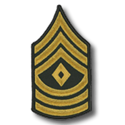
First Sergeant
A First Sergeant (1SG) is a senior non-commissioned officer who serves as the principal enlisted leader of a company. They are responsible for maintaining discipline, morale, and standards among the troops while advising the Company Commander on all enlisted matters. First Sergeants oversee training, enforce policies, and ensure the welfare of soldiers under their command. Their role bridges the gap between enlisted personnel and the officer corps, making them a cornerstone of company leadership.
To be promoted to this rank, you must be assigned to the following slots:
Ranger Company First Sergeant Billet

First Sergeant
First Sergeant
A First Sergeant (1SG) is a senior non-commissioned officer who serves as the principal enlisted leader of a company. They are responsible for maintaining discipline, morale, and standards among the troops while advising the Company Commander on all enlisted matters. First Sergeants oversee training, enforce policies, and ensure the welfare of soldiers under their command. Their role bridges the gap between enlisted personnel and the officer corps, making them a cornerstone of company leadership.
To be promoted to this rank, you must be assigned to the following slots:
Ranger Company First Sergeant Billet
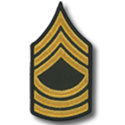
Master Sergeant
A Master Sergeant (MSG) is a senior non-commissioned officer who provides expertise and leadership at the company or battalion level. They are experienced leaders who manage training, administration, and daily operations within their assigned element. Master Sergeants advise officers, support mission planning, and ensure standards are upheld across the unit. Their role emphasizes technical proficiency, stability, and mentorship, guiding both junior NCOs and enlisted personnel.
To be promoted to this rank, the following must be obtained:
Time in Grade 120 Days Minimum
Basic Leadership Course (BLC) Certified
Advanced Leadership Course (ALC) Certified
Master Leadership Course (MLC) Certified
Ranger Tab Certified
Expert Infantryman Badge (EIB) Certified
To be promoted to this rank, you must also be assigned to one of the following slots:
Ranger Company First Sergeant Billet

Master Sergeant
Master Sergeant
A Master Sergeant (MSG) is a senior non-commissioned officer who provides expertise and leadership at the company or battalion level. They are experienced leaders who manage training, administration, and daily operations within their assigned element. Master Sergeants advise officers, support mission planning, and ensure standards are upheld across the unit. Their role emphasizes technical proficiency, stability, and mentorship, guiding both junior NCOs and enlisted personnel.
To be promoted to this rank, the following must be obtained:
Time in Grade 120 Days Minimum
Basic Leadership Course (BLC) Certified
Advanced Leadership Course (ALC) Certified
Master Leadership Course (MLC) Certified
Ranger Tab Certified
Expert Infantryman Badge (EIB) Certified
To be promoted to this rank, you must also be assigned to one of the following slots:
Ranger Company First Sergeant Billet
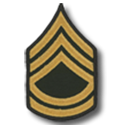
Sergeant First Class
A Sergeant First Class (SFC) is a senior non-commissioned officer who typically serves as a platoon sergeant or in other key leadership roles. They are responsible for assisting the platoon leader, mentoring squad leaders, and ensuring missions are executed effectively. Sergeant First Class leaders oversee training, discipline, and welfare within their platoon, acting as the backbone of day-to-day operations. Their experience and guidance make them a vital link between enlisted soldiers and the officer corps.
To be promoted to this rank, the following must be obtained:
139 Promotional Points
Time in Grade 77 Days Minimum
Basic Leadership Course (BLC) Certified
Advanced Leadership Course (ALC) Certified
Ranger Tab Certified
Expert Infantryman Badge (EIB) Certified
To be promoted to this rank, you must also be assigned to one of the following slots:
Ranger Platoon Sergeant Billet

Sergeant First Class
Sergeant First Class
A Sergeant First Class (SFC) is a senior non-commissioned officer who typically serves as a platoon sergeant or in other key leadership roles. They are responsible for assisting the platoon leader, mentoring squad leaders, and ensuring missions are executed effectively. Sergeant First Class leaders oversee training, discipline, and welfare within their platoon, acting as the backbone of day-to-day operations. Their experience and guidance make them a vital link between enlisted soldiers and the officer corps.
To be promoted to this rank, the following must be obtained:
139 Promotional Points
Time in Grade 77 Days Minimum
Basic Leadership Course (BLC) Certified
Advanced Leadership Course (ALC) Certified
Ranger Tab Certified
Expert Infantryman Badge (EIB) Certified
To be promoted to this rank, you must also be assigned to one of the following slots:
Ranger Platoon Sergeant Billet
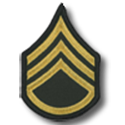
Staff Sergeant
A Staff Sergeant (SSG) is a seasoned non-commissioned officer who usually serves as a squad leader or in a similar leadership role. They are responsible for directing team leaders, ensuring training and discipline, and overseeing the welfare of the soldiers in their squad. Staff Sergeants focus on mission execution at the squad level, mentoring junior NCOs, and maintaining high standards of readiness. Their leadership ensures that small-unit operations run smoothly and effectively.
To be promoted to this rank, the following must be obtained:
108 Promotional Points
Time in Grade 70 Days Minimum
Basic Leadership Course (BLC) Certified
Advanced Leadership Course (ALC) Certified
Ranger Tab Certified
To be promoted to this rank, you must also be assigned to one of the following slots:
Ranger Platoon Sergeant Billet
Ranger Sniper Billet
Ranger Squad Leader Billet

Staff Sergeant
Staff Sergeant
A Staff Sergeant (SSG) is a seasoned non-commissioned officer who usually serves as a squad leader or in a similar leadership role. They are responsible for directing team leaders, ensuring training and discipline, and overseeing the welfare of the soldiers in their squad. Staff Sergeants focus on mission execution at the squad level, mentoring junior NCOs, and maintaining high standards of readiness. Their leadership ensures that small-unit operations run smoothly and effectively.
To be promoted to this rank, the following must be obtained:
108 Promotional Points
Time in Grade 70 Days Minimum
Basic Leadership Course (BLC) Certified
Advanced Leadership Course (ALC) Certified
Ranger Tab Certified
To be promoted to this rank, you must also be assigned to one of the following slots:
Ranger Platoon Sergeant Billet
Ranger Sniper Billet
Ranger Squad Leader Billet
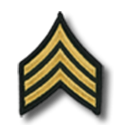
Sergeant
A Sergeant (SGT) is a junior non-commissioned officer who typically serves as a team leader within a squad. They are responsible for leading a small group of soldiers, ensuring tasks are carried out, and maintaining discipline and readiness at the team level. Sergeants mentor junior enlisted members, enforce standards, and serve as the first line of leadership in the chain of command. Their role is critical in translating orders from higher leadership into action on the ground.
To be promoted to this rank, the following must be obtained:
88 Promotional Points
Time in Grade 42 Days Minimum
Basic Leadership Course (BLC) Certified
Ranger Tab Certified
Operate within a Staff Shop
To be promoted to this rank, you must also be assigned to one of the following slots:
Ranger Sniper Billet
Ranger Squad Leader Billet
Ranger Team Leader Billet

Sergeant
Sergeant
A Sergeant (SGT) is a junior non-commissioned officer who typically serves as a team leader within a squad. They are responsible for leading a small group of soldiers, ensuring tasks are carried out, and maintaining discipline and readiness at the team level. Sergeants mentor junior enlisted members, enforce standards, and serve as the first line of leadership in the chain of command. Their role is critical in translating orders from higher leadership into action on the ground.
To be promoted to this rank, the following must be obtained:
88 Promotional Points
Time in Grade 42 Days Minimum
Basic Leadership Course (BLC) Certified
Ranger Tab Certified
Operate within a Staff Shop
To be promoted to this rank, you must also be assigned to one of the following slots:
Ranger Sniper Billet
Ranger Squad Leader Billet
Ranger Team Leader Billet
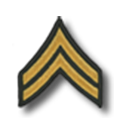
Corporal
A Corporal (CPL) is a junior non-commissioned officer who serves as a team leader or assistant squad leader. They are responsible for guiding a small group of soldiers, setting the example in discipline, training, and performance. Corporals bridge the gap between enlisted members and senior NCOs, often being the first step into formal leadership. Their role focuses on hands-on supervision, ensuring tasks are executed correctly while developing their own leadership skills.
To be promoted to this rank, the following must be obtained:
75 Promotional Points
Time in Grade 25 Days Minimum
Basic Leadership Course (BLC) Certified
Ranger Tab Certified
Operate within a Staff Shop
To be promoted to this rank, you must also be assigned to one of the following slots:
Ranger Sniper Billet
Ranger Team Leader Billet
Ranger Rifleman Billet

Corporal
Corporal
A Corporal (CPL) is a junior non-commissioned officer who serves as a team leader or assistant squad leader. They are responsible for guiding a small group of soldiers, setting the example in discipline, training, and performance. Corporals bridge the gap between enlisted members and senior NCOs, often being the first step into formal leadership. Their role focuses on hands-on supervision, ensuring tasks are executed correctly while developing their own leadership skills.
To be promoted to this rank, the following must be obtained:
75 Promotional Points
Time in Grade 25 Days Minimum
Basic Leadership Course (BLC) Certified
Ranger Tab Certified
Operate within a Staff Shop
To be promoted to this rank, you must also be assigned to one of the following slots:
Ranger Sniper Billet
Ranger Team Leader Billet
Ranger Rifleman Billet
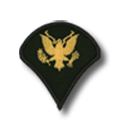
Specialist
A Specialist (SPC) is an enlisted rank that focuses on technical proficiency and individual skill rather than direct leadership. Specialists are expected to be dependable, disciplined, and capable of performing their duties with minimal supervision. They often serve as subject-matter experts in their roles, supporting their squad and contributing to mission success. This rank recognizes experience and competence, positioning the soldier as a reliable member of the unit while preparing them for potential advancement into leadership as an NCO.
To be promoted to this rank, the following must be obtained:
53 Promotional Points
90 Days Time in Service or 30 Days Time in Billet as a Fireteam Leader
To be promoted to this rank, you must also be assigned to one of the following slots:
Ranger Team Leader Billet
Ranger Rifleman Billet

Specialist
Specialist
A Specialist (SPC) is an enlisted rank that focuses on technical proficiency and individual skill rather than direct leadership. Specialists are expected to be dependable, disciplined, and capable of performing their duties with minimal supervision. They often serve as subject-matter experts in their roles, supporting their squad and contributing to mission success. This rank recognizes experience and competence, positioning the soldier as a reliable member of the unit while preparing them for potential advancement into leadership as an NCO.
To be promoted to this rank, the following must be obtained:
53 Promotional Points
90 Days Time in Service or 30 Days Time in Billet as a Fireteam Leader
To be promoted to this rank, you must also be assigned to one of the following slots:
Ranger Team Leader Billet
Ranger Rifleman Billet
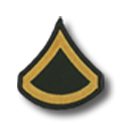
Private First Class
A Private First Class (PFC) is an enlisted rank that signifies growth beyond the initial entry level. They have demonstrated basic proficiency in soldiering skills and a solid understanding of unit standards. Privates First Class are expected to perform their duties reliably, support their team leaders, and continue building experience in training and operations. This rank marks the transition from a new soldier to a dependable member of the unit with greater responsibility.
To be promoted to this rank, the following must be obtained:
20 Promotional Points
60 Days Time in Service
To be promoted to this rank, you must also be assigned to one of the following slots:
Ranger Rifleman Billet

Private First Class
Private First Class
A Private First Class (PFC) is an enlisted rank that signifies growth beyond the initial entry level. They have demonstrated basic proficiency in soldiering skills and a solid understanding of unit standards. Privates First Class are expected to perform their duties reliably, support their team leaders, and continue building experience in training and operations. This rank marks the transition from a new soldier to a dependable member of the unit with greater responsibility.
To be promoted to this rank, the following must be obtained:
20 Promotional Points
60 Days Time in Service
To be promoted to this rank, you must also be assigned to one of the following slots:
Ranger Rifleman Billet
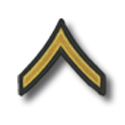
Private Second Class
A Private Second Class (PV2) is a junior enlisted rank that follows initial entry into the unit. They have gained basic experience and continue developing their soldiering skills under the guidance of team leaders and NCOs. Privates Second Class are expected to show improvement in discipline, proficiency, and reliability while contributing to their squad’s effectiveness. This rank reflects growth from the entry-level stage and progression toward becoming a more dependable member of the unit.
To be promoted to this rank, the following must be obtained:
11 Promotional Points
30 Days Time in Service
To be promoted to this rank, you must also be assigned to one of the following slots:
Ranger Rifleman Billet

Private Second Class
Private Second Class
A Private Second Class (PV2) is a junior enlisted rank that follows initial entry into the unit. They have gained basic experience and continue developing their soldiering skills under the guidance of team leaders and NCOs. Privates Second Class are expected to show improvement in discipline, proficiency, and reliability while contributing to their squad’s effectiveness. This rank reflects growth from the entry-level stage and progression toward becoming a more dependable member of the unit.
To be promoted to this rank, the following must be obtained:
11 Promotional Points
30 Days Time in Service
To be promoted to this rank, you must also be assigned to one of the following slots:
Ranger Rifleman Billet

Private
A Private (PVT) is the entry-level enlisted rank and forms the foundation of the unit. They are primarily focused on learning basic soldiering skills, following orders, and supporting their team in training and operations. Privates gain experience under the guidance of NCOs, developing discipline and proficiency with equipment and tactics. This rank represents the beginning of a soldier’s career and their introduction to the responsibilities of military service.
To be promoted to this rank, the following must be obtained:
Basic Combat Training (BCT) Certified
Ranger Assessment and Selection Program (RASP) Certified
To be promoted to this rank, you must also be assigned to one of the following slots:
Ranger Rifleman Billet

Private
Private
A Private (PVT) is the entry-level enlisted rank and forms the foundation of the unit. They are primarily focused on learning basic soldiering skills, following orders, and supporting their team in training and operations. Privates gain experience under the guidance of NCOs, developing discipline and proficiency with equipment and tactics. This rank represents the beginning of a soldier’s career and their introduction to the responsibilities of military service.
To be promoted to this rank, the following must be obtained:
Basic Combat Training (BCT) Certified
Ranger Assessment and Selection Program (RASP) Certified
To be promoted to this rank, you must also be assigned to one of the following slots:
Ranger Rifleman Billet

Recruit
A Recruit (RCT) is the entry-level position for new members of the unit. They are in the process of learning basic procedures, standards, and expectations while undergoing initial training. Recruits focus on developing discipline, teamwork, and fundamental soldiering skills under the guidance of their leaders. This rank represents the beginning of their journey in the unit and the first step toward becoming a fully integrated and effective member.
To be promoted to this rank, the following must be completed:
Enlistment Application Process

Recruit
Recruit
A Recruit (RCT) is the entry-level position for new members of the unit. They are in the process of learning basic procedures, standards, and expectations while undergoing initial training. Recruits focus on developing discipline, teamwork, and fundamental soldiering skills under the guidance of their leaders. This rank represents the beginning of their journey in the unit and the first step toward becoming a fully integrated and effective member.
To be promoted to this rank, the following must be completed:
Enlistment Application Process
